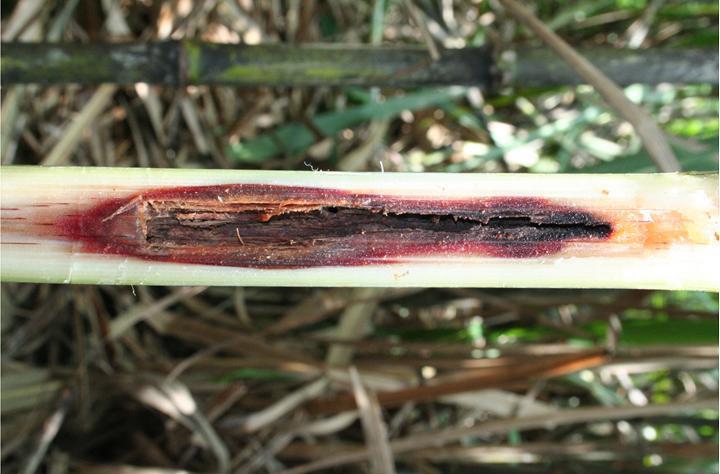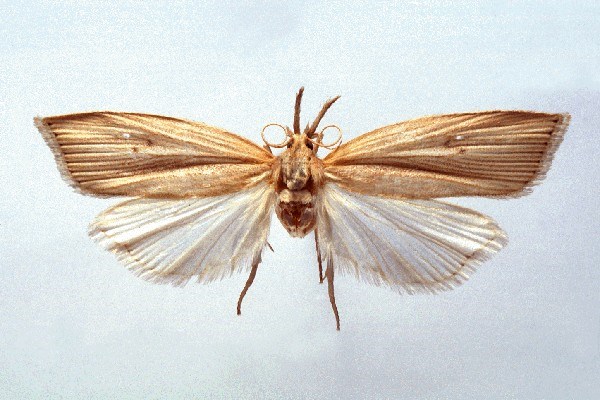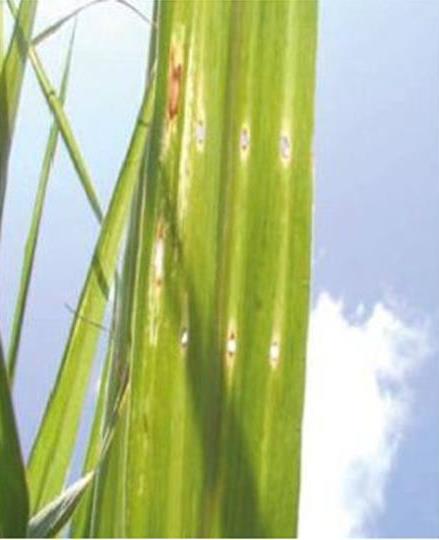
Sugarcane internode borer
| Primefact number | Edition | Published | Author |
|---|---|---|---|
| 1510 | First | Aug 2017 | Plant Biosecurity and Product Integrity |



Sugarcane internode borer (Chilo sacchari-phagus) is an exotic plant pest not present in Australia. This insect is a serious threat to Australia’s sugarcane industry.
Sugarcane internode borer (Chilo sacchari-phagus) is a stem boring insect which is a serious pest of sugarcane, maize and sorghum. Its caterpillars damage these hosts by tunnelling inside their plant stems (Figure 1).
Notifiable status
If you suspect sugarcane internode borer (Chilo sacchari-phagus):
- Call the Exotic Plant Pest Hotline 1800 084 881
- Email biosecurity@dpi.nsw.gov.au with a clear photo and your contact details
Description
Sugarcane internode borer moths have small, yellow-brown bodies with 24-36 mm wingspans. They have 1-2 dark spots on their dull, light-brown forewings. The hindwings are dirty-white to light-brown in the male and silky-white in the female moths (Figure 2).
The caterpillars have brown heads, with two violet longitudinal stripes along their white bodies. Fully grown caterpillars are up to 30 mm long.
The flat, oval, creamy-white eggs are about 1 mm long. Clusters of 7-30 eggs are laid in 2-3 over-lapping rows on the host plants.
Damage
Sugarcane internode borer caterpillars damage their hosts by first feeding on the young leaves. They eat through the young, tightly rolled leaves, creating leaf patterns of small, scattered “shot holes” when these leaves unfurl (Figure 3). Superficial feeding by the caterpillars on the leaf surfaces can also produce small, transparent “window panes” on the leaves.
The caterpillars next feed on the plant growing points, producing “dead hearts” (the youngest still unfolded leaves wilt and die) in the stems. They bore extensive tunnels inside the stems, causing broken plant stalks and widespread crop lodging. The tunnelled stalks are also easily broken by wind.
Caterpillars also tunnel into the softer internodes at the top of plants, causing reduced growth, “bunchy top” (lateral shoot growth) and “dead tops” (death of the growing point, which can kill the plant) in infested crops. In Reunion reduced cane growth due to these pests can cause 25% yield losses in heavily infested sugarcane crops under crop protection.
Lifecycle
Sugarcane internode borers have four lifecycle stages: eggs, caterpillars, pupae and moths.
Female moths lay their egg clusters on both sides of the host plant’s leaves. The eggs are also laid on the leaf sheaths. After 6-7 days incubation the eggs hatch into caterpillars.
The caterpillars are very active and can drop from the leaves on silken threads before being carried off by the wind. They feed on the leaves before tunnelling into the leaf sheaths or plant stems. Inside the plant stems the caterpillars turn into pupae. They emerge as adult moths after 7-10 days.
The female moths live for eight nights after emergence, when they mate and lay their eggs on nearby host plants. Sugarcane internode borers have six overlapping generations a year, with each lifecycle lasting 8-12 weeks.
Host range
The main host plant of the sugarcane internode borer is sugarcane (Saccharum officinale). Other hosts include wild sugarcane (Saccharum spp.), maize (Zea mays) and sorghum (Sorghum bicolor).
Spread
Sugarcane internode borers are spread from farm-to-farm by infested plant material, farm machinery and vehicles. The caterpillars move about, within and between the host plants, while the moths fly between the host plants at night.
Distribution
Sugarcane internode borer is a native insect of Asia, which has since become established in Africa. It is found in eastern and southern Asia, as well as Comoros, Madagascar, Mauritius, Mozambique, Reunion, South Africa, and Tanzania.
Actions to minimise risks
Put in place biosecurity best practice actions to prevent entry, establishment and spread of pests and diseases:
- practice “Come clean, Go clean”
- ensure all staff and visitors are instructed in and adhere to your business management hygiene requirements
- source propagation material of a known high health status from reputable suppliers
- monitor your crop regularly
- keep records

